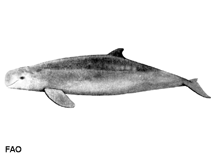Orcaella brevirostris (Owen, 1866)
Irrawaddy dolphin| Native range | All suitable habitat | Point map | Year 2050 |

|
| This map was computer-generated and has not yet been reviewed. |
| Orcaella brevirostris AquaMaps Data sources: GBIF OBIS |
Classification / Names Populärnamn | synonymer | CoL | ITIS | WoRMS
Mammalia | Cetartiodactyla | Delphinidae
Environment: milieu / climate zone / djupintervall / distribution range Ekologi
Pelagiska; sötvatten; brackvatten; djupintervall 0 - 200 m, usually 1 - 10 m. Tropical; 90°N - 10°S, 50°E - 125°E
Distribution Länder | FAO områden | Ekosystem | Förekomster | Utplanteringar
Indo-Pacific and Asia Inland Waters. [Malampaya Sound population: IUCN 2010 (Ref. 84930): CR, C2a(i,ii); D.]
Length at first maturity / Size / Weight / Age
Könsmognad: Lm ? range ? - ? cm Max length : 275 cm TL hane/ej könsbestämd; (Ref. 1394)
Life cycle and mating behavior Könsmognad | Reproduktion | Lek | Eggs | Fecundity | Larvae
Main reference
referenser | Koordinator | Medarbetare
Jefferson, T.A., S. Leatherwood and M.A. Webber 1993 FAO species Identification Guide: Marine Mammals of the World. Rome, FAO. 320 p. + 587 figures. (Ref. 1394)
IUCN Red List Status
(Ref. 130435: Version 2025-1)
CITES status (Ref. 108899)
CMS (Ref. 116361)
Threat to humans
Human uses
Fiskeri: kommersiell
FAO - fiskeri: landings, species profile | FishSource | Sea Around Us
Verktyg
Ytterligare information
Max. ages / sizes
Length-weight rel.
Length-length rel.
Length-frequencies
Mass conversion
Abundans
Könsmognad
Fecundity
Lek
Eggs
Egg development
Larvae
Internet-källor
BHL | BOLD Systems | CISTI | DiscoverLife | FAO(fiskeri: species profile; publication : search) | Fishipedia | GenBank (genome, nucleotide) | GloBI | Gomexsi | Google Books | Google Scholar | Google | PubMed | Tree of Life | Wikipedia (Go, sök) | Zoological Record



